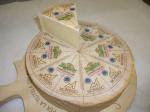Montasio is a partially skimmed raw cow’s milk cheese and is produced in the high Alpine region of Friuli-Venezia Giulia. This cheese is a close relative to the more well known Asiago. that is produced in the nearby region of Veneto. Montasio was given the highly coveted D.O.C status in 1986 and is the mainstay of the local economy.
This delicious cheese is becoming more popular for three fundamental reasons: the area where it is produced influenced by the climate, the land, the fodder, the cattle herds, the rearing methods used by the herdsmen; the milk from which the Montasio is made gives it the flavor and scent of the mountain pastures where the cows are taken to graze.
Italian Cheese Sampler from Amazon
Details: Montasio cheese is made from full fat milk, from both the morning and evening milkings. The milk is heated to a temperature between 32° - 34°C , which does not dry the curd excessively, and it is salted when dry. There are three kinds of Montasio: Montasio da tavola (fresh and ready to eat), which has had a ripening period of a minimum of 60 days: Montasio mezzano (medium cured), which has had a maturing period of between 4 to 9 months: Montasio stagionato or vecchio (aged), which has a more distinct flavor and smell, provided the maturing process has been more than 12 months. The type of Montasio that is imported to the US is usually the mezzano version although the vecchio version is becoming somewhat popular now. As Montasio ages it becomes more granular and crumbles easily which makes it a nice grating cheese. Its taste also becomes saltier and its rind becomes darker and drier as it ages. For those who worry about these things the fat content of this cheese is about 45%.
Tasting: Montasio has a subtle butterscotch flavor and a light gray/beige rind and a beige interior paste that has small holes throughout. The relatively high butterfat content of the raw milk gives it a rich flavor and a subtle earthy undertone that compliments other foods. Montasio’s flavor is, for the most part mild, and can be overshadowed by other more flavorful cheeses so when serving it allow it to stand on its own as a table cheese with fresh pears and crusty bread, grated over pasta and salads or melted over vegetables. Montasio is well known in Italy as the cheese used to make frico which is a fried cheese and potato or polenta cake. When making frico you can substitute Asiago in your recipe if you can not find Montasio.
When purchasing Montasio look for cheese that is not excessively dry or has a cracked rind nor should it have a gray or dark amber interior paste as these are all signs that the cheese is past its prime and should be avoided. Real Montasio that is DOP certified will have a large M stamped on the rind and the name Montasio DOP stamped below it.
Wine parings: The Mezzano version can be served with wines from the Grave del Friuli region like Merlot, Cabernet or Pinot Nero, the Vecchio version should be served with big reds like Amarone or Gattinara.


